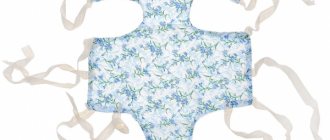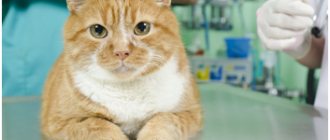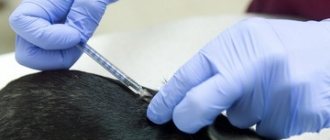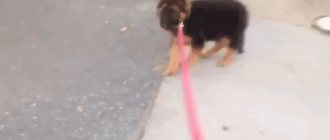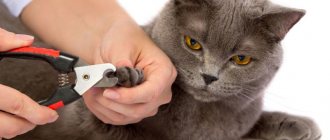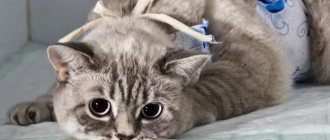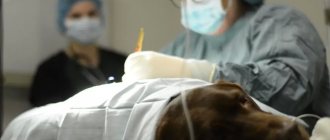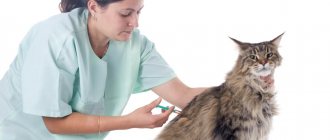Postoperative care is the most important aspect of sterilization of cats, since after the operation all care for the animal rests with the owners. The most pressing question for many remains how long to wear a blanket after sterilizing a cat. The main problem is that animals refuse to wear a protective bandage and try with all their might to free themselves from it. Looking at the suffering of their pets, the owners try to remove the bandage early, without even realizing that such a decision is not always the right one.
Why is it needed?
A blanket is required for an animal undergoing abdominal surgery. It performs several functions:
- covers the postoperative suture;
- prevents contamination and infection;
- protects against scratching and licking of the wound surface.
When the stitches are treated, the dressing or bandages are changed, it is not always necessary to remove the bandage. If the postoperative suture is located at the bottom, it is enough to untie several ties and bend the edges to gain access to the desired area.
If the bandage becomes contaminated with discharge from the wound, it will have to be replaced to prevent infection from entering the seam and the development of inflammation.
Often, immediately after surgery, a blanket is placed on the cat. However, with intradermal sutures there is no need to protect the surgical field. But such sutures are rarely used during sterilization.
Transportation after surgery
Before taking your pet for sterilization, make sure you have a reliable and spacious carrier. Lay a strong oilcloth around the entire perimeter of the bottom, and lay a clean layer of cotton fabric on top of it. The animal must be laid on its right side and covered with a blanket or warm blanket. Under the influence of anesthesia, the cat's body temperature drops significantly, the cat's pulse and breathing become slower. During this period, your pet is especially vulnerable to drafts and cold air.
When the operation takes place during a cool time, you need to ensure that your pet is well warmed up when returning from the clinic.
To increase the warmth in the carrier, you can use a heating pad or a durable bottle filled with hot water on your pet's back. While moving, carefully monitor the possible movement of the container, avoiding the appearance of an object in the wound area, since heat entering the suture area can cause bleeding.
Once you get home, you can leave your pet inside the carrier for a while, but only if there is enough space. If the animal is cramped and uncomfortable, place it on the floor in a warm room, spreading oilcloth and fabric. At home, there is no need to additionally cover your pet . Do not place your pet on sofas or any other high furniture. Try to keep your cat moving less.
What to do if the cat takes off the blanket on its own
The animal will not be able to remove the bandage that is properly secured. A cat that has been castrated along the linea alba should be in a blanket until the postoperative wound heals.
If your cat removes the bandage, you must carefully read the instructions to secure it correctly and prevent it from being removed in the future.
When treating a seam using a special spray, you do not need to use a blanket (in this case, the wound is reliably protected from contamination and infection).
Rehabilitation of cats at home
Sterilization is now a completely ordinary operation; many owners seek such a service at a veterinary clinic or call a doctor at home to avoid unwanted offspring.
The procedure does not take much time, and after a certain period the animal begins to live a normal life. But until complete recovery from surgery, it is important to provide proper care for the cat. Otherwise, there is a risk of postoperative complications arising from lack of attention to the cat and ignoring simple rules. In practice, several sterilization methods are used. The classic method is to perform an operation by cutting the peritoneal line of the abdomen. After internal manipulations, the incision is sutured. This is the most commonly used sterilization option. There is also the option of making an incision from the side; this method has a high risk of injury compared to others, since it is sometimes difficult to remove the uterus due to the small size of the hole made. They also perform laparoscopy on cats. This method is the safest. In addition, it is not practiced in all clinics.
Depending on which surgical method was chosen, your veterinarian will prescribe postoperative procedures. But there are also general rules regarding caring for a cat after sterilization. The operation is an invasive procedure, so the impact on the body is quite serious. In this regard, you should not leave your cat alone. It is necessary to monitor it and care for it properly.
Caring for a cat after anesthesia
Sterilization of cats is always carried out under anesthesia. During medical sleep, body temperature decreases, so after sterilization, provide the animal with additional warmth. If you plan to take her home right away, it is better to place additional fabric on the bottom of the carrier. It is also recommended to wrap the kitty in something warm, especially if the street conditions are not pleasant. Naturally, you should wrap your pet as carefully as possible.
At home, during the first 24 hours after surgery, the cat will recover from anesthesia. It always looks strange and sometimes scary, but don’t worry, this is a completely normal situation. The pet is poorly oriented in space, sometimes does not understand where to go and what to do. She may take a few awkward steps, then lie down, or she may simply walk backwards. You should not react violently to what is happening, much less laugh.
It is necessary to carefully pick up your pet and carry it to the bedding to ensure proper rest. Trying to walk or run will still lead to failure, so it is better if the cat is in a lying position. A cat's recovery from anesthesia usually takes up to 8 hours, but for some pets it takes longer.
Important!
After anesthesia, a cat always does not behave quite normally, but if the owner is very embarrassed by something or if the period of “coming out of anesthesia” has been prolonged, then call the veterinarian immediately.
Try to organize a safe space so that the cat does not harm itself after anesthesia. All wires and other objects that could become entangled should be removed from the floor surface. Also try to cover the furniture so that the cat does not try to jump into it. Too sudden movements can cause the seams to come apart. Try to provide a calm environment and keep other animals and children away from the sterilized pet. It would be optimal to isolate the pet so that no one bothers her at all.
Physiological needs after surgery
On the first day after surgery, the cat may sometimes experience vomiting and involuntary urination. These processes are also within normal limits, so do not scold your cat under any circumstances. You just need to remember that the described situation can happen and be careful when letting the animal onto sofas, beds, and expensive carpets. You can keep a bag ready for the animal to vomit in. You can tell that a cat is about to vomit by its continuous licking.
Know!
The cat may not eat for the first day after surgery, but it must have access to water.
You can provide water to your cat 3 hours after surgery. But it is recommended to feed the cat only 5 - 7 hours after sterilization. It is recommended to reduce portions. The optimal size is about a third of the usual amount. If before the operation the cat ate mainly dry food, then it is recommended to abandon it during recovery. It is better to give preference to soft food. In the first three days, the cat may have a poor appetite, but if it continues to refuse food, then you should consult a veterinarian.
How to remove a blanket correctly and when to do it
How long a cat can wear a bandage after sterilization depends on the method of surgery, the state of health, and the behavior of the animal.
In most cases, it can be removed after 1-1.5 weeks (depending on the decision of the veterinarian). If threads were used during the operation, sutures will need to be removed. After their removal, you can stop wearing the bandage any further. If the cat's sutures are removed, it means the healing process has been successful.
It is necessary to extend wearing the bandage for 2 or 3 days if:
- the animal is active, runs and jumps a lot;
- the cat licks the incision area;
- After examining the animal, the doctor decided to postpone removing the stitches for a while.
After 5-7 days, you can remove the bandage if self-absorbable suture material was used during the operation.
Extending the life of the blanket may be necessary as a result of:
- poor scarring;
- impaired coordination in the animal during the period after surgery;
- vigorous licking of the incision site.
Full or partial sterilization?
Complete sterilization, which is called ovariohysterectomy, means the removal of all the reproductive organs of the cat. During a partial procedure called an oophorectomy, only the ovaries are removed. Veterinarians recommend prioritizing complete neutering to save your cat from additional surgery in the future. Over time, inflammation may begin in the remaining uterus, which will require repeated intervention and anesthesia, which is very dangerous for an animal in old age.
Early withdrawal
How many days after sterilization a cat will need to use a bandage depends on many conditions. You can reduce the duration of use of the blanket if:
- the pet becomes aggressive and tries in every possible way to get rid of the blanket;
- the cat behaves passively, lies most of the time, refuses food and water, is afraid to walk;
- the pet does not rise from its bed, signs of deterioration in health appear: the nose becomes hot, weakness and lethargy appear;
- abrasions are noticeable in places of contact with the bandage;
- the blanket appears dirty or torn.
Processing and removal of seams
The sterilization operation is carried out under anesthesia; the owner needs not only to properly remove the animal from this state (properly contain, feed, give water), but also take care of the cleanliness of the wound.
The procedure for treating sutures begins on the third day after sterilization
The procedure for treating sutures begins on the third day after sterilization, at intervals of 2 times a day.
Algorithm of actions:
- Calm the beast, remove the bandage.
- Use a cotton swab soaked in an antiseptic (without alcohol) to generously moisten the wound surface with gentle movements.
- Remove hairs and dried blood.
- Inspect for inflammatory processes.
- Put on a bandage.
Attention! In some cases, to speed up healing, cat owners apply iodine or brilliant green to the stitches. It is strictly not recommended to do this: the drugs dry out the edges of the wound, inhibit recovery processes, and can lead to chemical burns of the skin.
Contraindications after installation of threads
Despite the minimally invasive procedure, after installing the threads you cannot do the following:
- take a hot bath, go to the bathhouse, pool and sauna - thermal exposure provokes the spread of edema;
- sunbathing in the sun and in a solarium - ultraviolet rays provoke the appearance of pigment spots at the puncture sites;
- mechanically influence the skin - rub, massage, scrub, rub (this carries a risk of infection and asymmetry;
- physically stress the body, lift weights, go to fitness and play sports - physical activity increases swelling and blood flow to the face, and can also lead to thread displacement.
The listed restrictions after thread lifting must be observed for one month, especially carefully in the first two weeks. After thread lifting, you cannot apply decorative cosmetics, use creams and tonics. The use of foundation and powder is allowed on the second or third day.
Immediately after threads on the face, you cannot do myostimulation, microcurrent therapy, plasma lifting, hardware or manual massage.
What to replace it with?
If a person is not comfortable with sewing, then for such work he will need children's clothing in the form of a bodysuit. You can make a blanket from scrap materials. If the animal is small, a belt made from a sock will do.
It is important to remember that the sock must be completely new and never used. Slots are made in the designated places through which the paw can be inserted
However, such a blanket is unreliable because it can be easily removed.
For an adult cat, a blanket made from tights is suitable
It is important that the product has increased density. In addition to tights, you can use a pant leg or sleeve cut off from unnecessary clothing
As in the version with a sock, holes for the limbs are cut in the required places. A good option that replaces the cat wrap is a baby bodysuit.
Warm
Cats, which are representatives of hairless breeds, often freeze when there are cold seasons outside the window. This not only causes significant discomfort for pets, but can also lead to the development of colds. In such circumstances, a special warm blanket would be an excellent solution.
Most often, caring owners of Sphynxes and Cornish Rexes turn to such things. These types of blankets look like simple sleeveless vests.
The best and most comfortable blankets are warm blankets made from soft fabric with large pile. Such things effectively protect hairless or short-haired cats from low temperatures and cold gusts of wind. Even during a walk, your pet will be warm and comfortable in a cozy blanket.
Separately, it is worth highlighting the knitted woolen blankets that fit the body well. These specimens are especially warm and have an excellent warming effect. They are very comfortable for cats and kittens.
A knitted wool blanket can easily be an excellent replacement for cat fur.
Literature
- Belyaev A.N., Kozlov S.A., Taratykov I.B., Novikov E.I. Patient care in a surgical clinic: textbook. allowance. – Saransk: Mordovian University Publishing House, 2003. – 136 p.
- Buyanov V. M. Egiev V. N. Udotov O. A. Surgical suture. – M.: Antis, 2000. – 92 p.
- Zoltan J. Operating technique and conditions for optimal wound healing. – Budapest: Publishing House of the Academy of Sciences of Hungary, 1983. – 175 p.
- Mironova E. N. Fundamentals of physical rehabilitation. – M.: MOO “Academy of Safety and Survival”, 2016 – 310 p.
- Semenov G.M., Petrishin V.L., Kovshova M.V. Surgical suture - St. Petersburg: Peter, 2001. - 256 p.
Recovery after thread lifting
The appearance of the face after thread lifting changes every day.
Immediately after installing the threads
After the lift is completed, there may be a temporary disruption of the facial muscles. This is due to the action of the anesthetic. After one to two hours the side effect will go away.
Sometimes small irregularities, depressions in the skin at the places where the needle is inserted and withdrawn, and thread lines are noticeable. This is a normal reaction that goes away after the soft tissues get used to the new position.
By evening the swelling increases. Sometimes it goes beyond the correction limits.
1-3 day
Excessive skin tension is felt. It seems as if the beautician lifted the tissue too much. The unnaturalness will go away after the swelling goes down.
The first days after the procedure, it is not advisable to gesticulate strongly, laugh, or eat hot foods, so as not to dislodge the threads.
The next day, bruising may appear. Local swelling and minor bruises after threads are not a reason to panic. Already on the third day, the primary swelling subsides.
If the procedure was carried out to correct age-related changes in the lower third of the face, the cosmetologist will recommend wearing a bandage after thread lifting for one week. The first day it is worn around the clock.
4-7 day
Bruises are dissolving. Swelling of soft tissues goes away. You are allowed to wash your face with boiled water without using cosmetics.
Before going outside, you should protect your skin from ultraviolet rays.
8-14 day
After 10 days, the skin smoothes out and unevenness disappears. After two weeks the swelling goes away completely.
Sleeping on your side is allowed, but sleeping with your face in the pillow is not yet possible.
Choosing a sanitary dressing
You need to take care of protective equipment for your pet in advance, even before the scheduled operation. Then your pet will quickly get used to the medical gown, and wearing it after sterilization will not aggravate the stressful condition. Prepare at least two hygiene items to replace them after contamination.
When purchasing a product, pay attention to its appearance and fabric composition.
Material
Medical blankets in pharmacies at veterinary hospitals are usually made of non-woven fabric. This base does not contain lint and does not crumble if you need to trim the product to make it more comfortable for the animal. The pressed fibers perfectly absorb liquid, keeping the surface of the wound dry. Another advantage of such a base is its resistance to tearing by claws, as well as a long service life. The product can withstand repeated washing and does not affect your pet's skin.
Factory blankets are sewn from different fabrics:
- cotton;
- viscose;
- spunbond;
- meltblown.
Size
Before purchasing a product, you need to weigh the animal, and also determine the circumference of the chest (behind the front legs). The length of a large bandage will be 7 cm longer. If the bandage is chosen correctly, then the width of the open part of the pet’s back is no more than 8–9 cm. The volume of the product is easy to adjust with ties, but the size remains unchanged.
Factories usually sew post-operative blankets for adult cats weighing 3–5 kg. Finding a protective device for a kitten is more difficult. For him, the size of the product along the length of the body from the base of the neck to the beginning of the tail will be 28 cm, and the model range starts from 38 cm with a chest circumference of 31 cm. Large animals with a body weight of 6–10 kg will be suitable for a protective bandage with dimensions of 42x35 cm.
Model type
There are several types of medical blankets for cats. They differ in the processing of the holes for the paws and the way the bandage is secured to the animal. A one-piece product with slits is less common than a coverlet that covers the limbs. The sleeveless robe is trimmed with a durable piping that covers all the edges and prevents the fabric from fraying.
A blanket with cutouts for cat paws is used in the treatment of back wounds
There are also expensive models with push-button clasps on sale. They are located on both sides near the animal's neck. Dutch manufacturers have equipped the hygiene product with an internal pocket. A bandage with medicine is placed there.
Mammary tumor in cats
The incidence of mammary tumors in cats is slightly lower than in dogs and humans, but is still quite high and accounts for 17% of all feline neoplasms. For males it is 1%. The peak incidence occurs at 10 years of age.
Hormone dependence
Everything is about the same as in dogs. Early sterilization significantly reduces the risk of developing breast cancer
According to studies that did not take into account the age of sterilization, but only its fact: AMF in sterilized cats occurs 2 times less than in non-sterilized ones. However, it is worth noting that most of the cats in the study were neutered before they were six years old. The use of synthetic analogues of progesterone and estrogen increases the risk of developing tumors
ESPECIALLY MALES!!
Regarding other factors (genetic), everything is the same as in dogs. And it has no practical significance at this stage of development of veterinary medicine.
Usually animals with a single neoplasm or multiple ones (approximately 50/50) are admitted. In many cases there is invasion into the skin or underlying floaters and in 20% there is ulceration. In advanced cases, and this is often, despite the availability of information, there are detectable metastases in regional lymph nodes, or distant metastases in parenchymal organs, lungs, pleura, diaphragm or adrenal glands. Pleural carcinomatosis with pleural effusion and, as a consequence, the development of dyspnea in the animal are not uncommon.
Consequences and complications of the postoperative period
Any surgical intervention is stressful for the body. Its consequences depend on the age, weight, general health of the patient, methods and quality of treatment and other factors, but there are a number of the most common complications depending on the rehabilitation period.
Early
- Complications after anesthesia: a sharp rise or fall in temperature, constant temperature measurements, vomiting, tongue retraction, arrhythmia.
- Inflammatory processes: infection or suture dehiscence, swelling, redness, purulent discharge, peritonitis as a result of inflammation.
- Circulatory disorders: thrombosis, internal and external bleeding, hematomas, hematomas, etc.
- Painful sensations: any damage to tissue integrity is accompanied by a painful symptom. Rehabilitation after surgery to remove uterine fibroids allows you to minimize pain. Discomfort often occurs when urinating. This is considered normal, but still requires treatment.
- Disorders of urination and stool excretion, intestinal obstruction, etc. The impact of surgery affects metabolism and leads to various adverse consequences.
- Pneumonia, usually caused by prolonged bed rest.
Typically, these consequences and complications are characteristic of all surgical interventions, and not just for this particular disease.
Late
- Intestinal disorders.
- Hernias.
- Depression. The state of depression is caused by emotional exhaustion associated with an unpleasant diagnosis and subsequent treatment. Mood is affected by changes in lifestyle, thoughts about infertility, the presence of scars (they remain if abdominal surgery was performed, with laparoscopic surgery there are practically no traces), etc.
During the late period, the main healing processes are completed. Significant complications are rare.
Remote
Recurrence of the disease: This is usually due to the fact that the doctor did not eliminate the cause of the tumor or did not take into account other factors, such as hormone levels. Menopause: Hormonal changes cause various reactions in the body, including the early onset of menopause. Osteoporosis: the disease and subsequent surgery negatively affect the body's calcium levels
Its deficiency leads to increased bone fragility. Diseases of the genitourinary organs: this can be infertility (many operations, for example, laparoscopy of uterine fibroids, allow you to preserve reproductive function, but a number of surgical interventions lead to infertility immediately or after some time), vaginal prolapse, urinary incontinence, as well as diseases caused by non-compliance with the rules personal hygiene, doctor’s recommendations and infection. Transformation of benign cells into malignant ones: special attention should be paid to the condition of the mammary glands, since they are most at risk. Depression and other psychological problems... Complications can be determined not only at a doctor’s appointment
Increased body temperature, uncharacteristic discharge, burning sensation in the genital area and other changes are a reason to visit a specialist.
Complications can be determined not only at a doctor’s appointment. Increased body temperature, uncharacteristic discharge, burning sensation in the genital area and other changes are a reason to visit a specialist.
Recovery after surgery to remove uterine fibroids allows you to minimize the negative consequences.
Do's, Don'ts and Don'ts
Need to:
- monitor the condition of the blanket (bandage) - cleanliness, integrity and general comfort;
- continue to treat the cat for blood-sucking parasites, monitor the condition of the ears and schedule anthelmintic. The body, weakened by surgical intervention, has poor resistance to internal and external parasites;
- monitor your diet to avoid the development of constipation, and also reduce food portions than before the operation. Enhanced feeding or voluntary feeding can trigger the development of obesity. Neutered cats should consume almost a quarter less food.
Can:
- carefully pick up the animal in your arms, picking it up under the front and hind legs, without putting pressure on the stomach;
- take him for short walks under supervision;
- water as much as the cat wants;
- feed with special food for sterilized cats.
It is forbidden:
- allow the cat to bask on warm radiators and heaters after surgery;
- pick up the cat in your arms for a month, picking it up only by the front paws;
- smear the seams with any alcohol-containing substances (iodine, brilliant green, chloramphenicol, etc.) - there is a high probability of burns;
- leave food in the morning for the whole day (especially in the summer). Food should be left out for 15-20 minutes in the morning and for the same amount in the evening to eliminate the possibility of overeating or poisoning from souring;
- remove the blanket until the stitches are completely healed;
- actively play with the cat and jump in the first two weeks.
Sterilization (castration) is not a complicated operation, the difficulty lies in the postoperative period. After surgery, you should definitely get recommendations from your veterinarian on how to care for your cat and strictly adhere to them. In any emergency situation, you must consult a specialist.
animalsprotectioncatspetcare

